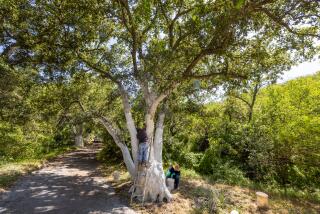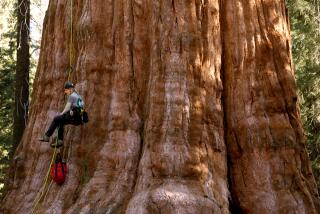‘Empire of the Beetle’ by Andrew Nikiforuk tells a sad human story: Book review
The bark beetle is well-known to Southern California for the trail of devastation it inflicted in late 2003 on vast tracts of pine forests surrounding the upscale resort communities of the San Bernardino Mountains.
Firestorms pushed by hot, dry Santa Ana winds claimed close to 300 homes that year in the heavily populated Lake Arrowhead area, a weekend playground that had become a tinderbox of dead and dying pines, all victims of drought and the pest the size of a grain of rice.
In “Empire of the Beetle,” Andrew Nikiforuk blames decades of fire suppression policies, increasingly dense forests and global warming for triggering bark beetle infestations that have placed forests across western North America at risk of the same fate.
Healthy pines would simply “pitch out” beetles by drowning them in sap. But in drought-stricken mountains, they breed several generations of swarms each year, which easily bore into the bark and consume the moist core where trees store and dispatch nutrients from roots to needles. Then they emit pungent pheromones that attract new swarms.
Nikiforuk’s accounts of futile efforts to thwart tree mortality episodes with clear-cutting, prescribed burns, electrocution, drowning, cancer-causing pesticides, liquid nitrogen, explosive charges and an early version of napalm are rather grim.
“By 2010, the insects had girdled and killed more than 30 billion lodgepole, pinyon, ponderosa and white bark pines as well as white spruce and Edelmann spruce” from Alaska to central Mexico, the Canadian journalist writes. “By collapsing entire forests, the bark beetle affected watersheds, fire regimes, carbon balances, local temperatures, and the livelihood of countless logging communities.”
Nikiforuk’s goal is not to shock, but to explain the altered rhythms of life for bark beetles and humans in a world so removed from what he calls “the pulse of nature” that “many urban dwellers can’t identify a single tree.”
This book is packed with statistics, vivid descriptions of bark beetle life cycles, and portraits of scientists and forest managers struggling to cope with beetle colonies that have, as he writes, “attacked conifers in swarms so large that they appeared on local airport radar to be rainstorms.”
But some of it is overkill. For example, in a chapter dealing with how beetles chewed their way through Alaska’s scenic Kenai Peninsula, he writes: “An average beetle weighs about two-1,000ths of an ounce. Given that there are 32,000 ounces in a ton, and that as many as 10,000 spruce beetles can infest just one tree, approximately 19,800 tons of beetles swarmed around Kenai for a decade. That’s like encountering a pod of 3,300 six-ton killer whales swimming through a forest, or encountering a mega wolf pack composed of 500,000 eighty-pound members.”
On the whole, this book is a serviceable, layman’s introduction to the bark beetle and its relentless exploitation of forests that have been altered by what Nikiforuk calls “human ignorance and arrogance.”
More to Read
The biggest entertainment stories
Get our big stories about Hollywood, film, television, music, arts, culture and more right in your inbox as soon as they publish.
You may occasionally receive promotional content from the Los Angeles Times.







